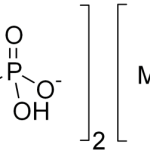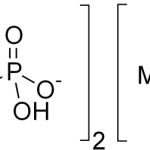What are E343 magnesium phosphates?
Magnesium phosphates E 343 (I, II) are food additives that act as acidity correctors, sequestering, stabilising (water retaining and thickening) and flavouring agents. They act as buffering, neutralising and organic antioxidants.
What forms do magnesium phosphates take?
Magnesium phosphates come in two forms:
- E 343 (I) MONOMAGNESIUM PHOSPHATE Synonyms: Magnesium dibasic phosphate; Monobasic magnesium phosphate; Monomagnesium orthophosphate, Chemical name: Monomagnesium dibasic monophosphate
Chemical formula Mg(H2 PO4 )2 * nH2O (where n = 0-4)
Molecular weight 218.30 g/mol (anhydrous).
Assay: Not less than 51,0 % after ignition calculated as P2 O5 on the ignited basis (800 °C ± 25 °C for 30 minutes). Description: White, odourless, crystalline powder, slightly soluble in water but soluble in acetic acid.
- E 343 (II) DIMAGNESIUM PHOSPHATE Synonyms: Magnesium acid phosphate; Dibasic magnesium phosphate; Dimagnesium orthophosphate; Secondary magnesium phosphate.
Chemical name: Dimagnesium monophosphate monoacid
Chemical formula MgHPO4 – nH2O (where n = 0-3)
Molecular weight 120.30 g/mol (anhydrous).
Assay: Not less than 96 % after ignition (800 °C ± 25 °C for 30 minutes) Description: White, odourless, crystalline powder, slightly soluble in water and ethanol, but soluble in acids[i]
Which foods contain food additives E343 (I, II)? Maximum permitted limits of use.
The additives E 343 (I ) and (II) are added to various foodstuffs, alone or in a mixture with E339 (I, II, III), E451, E341 (I, II, III) and E452. Mono- and dimagnesium orthophosphate shall be added in the following foodstuffs:
| Name of additive | Products in which it can be used | Maximum permitted dose |
| Magnesium phosphates | Fine bakery products | 20 g/kg |
| (i) Monomagnesium phosphate | Flour | 2.5 g/kg |
| (ii) Dimagnesium phosphate | Flour with ferment | 20 g/kg |
| Baking soda bread | 20 g/kg | |
| Liquid egg (egg white, yolk or whole egg) | 10 g/kg | |
| Magnesium phosphates
(i) Monomagnesium phosphate (ii) Dimagnesium phosphate |
in sterilised milk prepared by the UHT process | 1g/l |
| in partly dehydrated milk with a whey content of less than 28% s | 1,5 g/l | |
| in milk powder and skimmed milk | 2.5 g/kg | |
| https://www.pexels.com/ro-ro/cauta/SMANTANA/ | in pasteurised, sterilised UHT cream | 5g/kg |
| in butter made from sour cream; in cream and similar vegetable fat products; in fresh cheese (excluding Mozzarella) | 2g/kg | |
| in processed cheese and similar products | 20g/kg | |
| confectionery and sugar products, such as in dessert powder mixes | 7g/kg | |
| in desserts, in glazes such as syrups for pancakes, flavoured syrups for ice cream, in confectionery; | 3g/kg | |
| in icing sugar | 10g/kg | |
| in fruit preparations and candied fruit | 800mg/kg | |
| in chewing gum | “qs” | |
| in various plant products, such as processed potatoes (including processed, chilled, frozen, dehydrated products); | 5g/kg | |
| https://www.pexels.com/ro-ro/fotografie/pe-te-ine-in-maini-cu-it-file-10432847/ | in fatty fish or meat products; in fat spreads (excluding butter) and in unprocessed, chilled or frozen fish fillets.
in unprocessed, chilled, frozen molluscs and crustaceans; in fish and crustacean paste. |
5g/kg |
| in canned shellfish products | 1g/kg | |
| in meat products | 5g/kg | |
| in membranes for meat and vegetable products | 4g/kg | |
| can also be added to sauces, soups and broths | 3g/kg | |
| in dietary supplements | “qs” | |
| https://www.pexels.com/ro-ro/fotografie/cafenea-espresso-diminea-a-matinal-7125662/ | in coffee-based drinks for vending machines | 2g/kg |
| in liquid egg | 10g/kg | |
|
, |
in non-alcoholic flavoured drinks | 700g/kg |
| in energy drinks and table water | 0.5g/kg | |
| in cider and pear brandy, in milk-based chocolate and malt drinks,. | 2g/kg | |
| in plant protein drinks. | 20g/kg | |
| in food additives, other than carriers, in food additives: preparations of E 163 anthocyanins. | 40 000 mg/kg individually or in combination in the preparation (expressed as P2 O5 ) |
Need for the use of E343 additives
The use of magnesium orthophosphates is based :
- on their sequestering properties on heavy metal ions (Cu, Fe),
- on protein solubilisation capacity,
- on emulsifying and stabilising capacity in the manufacture of processed cheese.
- on their buffering capacity, as well as for the stabilisation of products in the breakfast cereal category. As a stabiliser they are also used in liquid eggs.
These additives are used to treat flour in the bakery industry, due to their antioxidant action and as anti-caking agents, and as antioxidants they are also used to prevent the appearance of rancid taste and smell in confectionery and pastry products.
They play an important role in the stabilisation of edible fats and oils, in fat spreads as well as in fatty fish and meat products, where they also have the ability to sequester heavy metal ions.
Are there any side effects from consuming the food additive E343?
The group of researchers who proposed “Re-evaluation of phosphoric acid – phosphates – di-, tri- and polyphosphates (E 338-341, E 343, E 450-452) as food additives and the safety of their use” concluded that from the available data it was clear that none of the phosphates are genotoxic in vitro or in vivo and that they are not carcinogenic. In addition, they pose no risk of reproductive or developmental toxicity.
The only significant adverse effects of phosphates in animal studies were nephrocalcinosis and tubulointerstitial nephropathy.
Although animal studies have reported that high phosphorus intake causes bone resorption or decreased bone formation, the group of researchers, felt that the observed effects on bone metabolism and bone mineralization in animals are not well enough characterized to infer an association with high dietary phosphate intake.
Clinical data indicated that in humans, in chronic exposure situations, adverse effects on the kidneys have been reported at ingested doses of phosphates three times lower than those causing adverse renal effects in animals.
JECFA (the international scientific expert group) has set a ‘Tolerable Upper Intake Level’ (UL) of 70 mg/kg body/day (expressed as phosphorus) for phosphates and polyphosphates, both naturally occurring in food but also ingested as food additives. The TMDI was established on the basis that “The lowest level of phosphate that produced nephrocalcinosis in the rat (1% P in the diet) is used as the basis for assessment”. [ii]
What are food additives?
Food additive’ means any substance not normally consumed as a food by itself and not used as a characteristic food ingredient, with or without nutritional value, the deliberate addition of which, for technological purposes, to food during manufacturing, processing, preparation, treatment, packaging, transport or storage results, or may reasonably be expected to result, in its transformation, or the transformation of its by-products, directly or indirectly, into a component of the food in question.
Food additives must be safe when used, there must be a technological need for their use, they must not mislead the consumer and their use must bring a benefit to the consumer. Misleading the consumer includes, but is not limited to, issues related to the nature, freshness, quality of the ingredients used, the extent to which a product or production process is natural or the nutritional quality of the product, including fruit and vegetable content.
The use and maximum levels of food additives should take into account the consumption of this food additive from other sources and the exposure of particular groups of consumers (e.g. allergic individuals) to the food additive. [iii]
Conclusions and Legislative Regulations E343
Magnesium phosphates are regulated at European level by Regulation (EU) No 1129/2011[iv] and at national level there is a regulation[v] (12 July 2002) on food additives for use in foodstuffs for human consumption, which sets maximum permitted limits for each category of food product where they may be used.
Phosphates (E 338-341, E 343, E 450-452) are authorised for 108 different uses (corresponding to 65 different food categories) according to Annex II of Regulation (EC) No 1333/2008 and data have been received for the majority of uses where food additives are authorised to be added.
Phosphates are food additives authorised in the European Union (EU) in accordance with Annexes II and III to Regulation (EC) No 1333/2008 on food additives. By regulation, the minimum and maximum total phosphorus levels for infant formula are set at 25 and 90 mg/100 kcal, in the case of soy-based infant formula the maximum level is 100 mg/100 kcal. The minimum and maximum levels for infant formulae for special medical purposes are set at 25 and 100 mg/100 kcal (Commission Delegated Regulation (EU) 2016/127 and Commission Delegated Regulation (EU) 2016/128 as well as Directive 2006/2006/Commission 141/EC and Commission Directive 1999/21/EC). 5
Author: dr. ing. Ancuta Fulvia Manolache
Bibliographical references
[i] Commission Regulation (EU) No 231/2012 of 9 March 2012 laying down specifications for food additives listed in Annexes II and III to Regulation (EC) No 1333/2008 of the European Parliament and of the Council (1) . https://eur-lex.europa.eu/legal-content/RO/TXT/PDF/?uri=OJ:L:2012:083:FULL&from=PT
[ii] Re-evaluation of phosphoric acid-phosphates – di-, tri- and polyphosphates (E 338-341, E 343, E 450-452) as food additives and the safety of proposed extension of use, https://efsa.onlinelibrary.wiley.com/doi/full/10.2903/j.efsa.2019.5674
[iii] Regulation (EC) No 1333/2008 of the European Parliament and of the Council of 16 December 2008 on food additives https://eur-lex.europa.eu/legal-content/RO/TXT/HTML/?uri=CELEX:32008R1333&from=GA
[iv] COMMISSION REGULATION (EU) No 1129/2011 of 11 November 2011 amending Annex II to Regulation (EC) No 1333/2008 of the European Parliament and of the Council by establishing a Union list of food additives https://eur-lex.europa.eu/legal-content/RO/TXT/?uri=celex%3A32011R1129
[v] STANDARD of 12 July 2002 on food additives for use in foodstuffs for human consumption) Published in the Official Journal No 722a of 3 October 2002.


